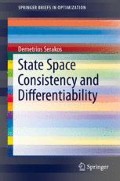Abstract
A causal input–output system may be described by a function space for inputs, a function space for outputs, and a causal operator mapping the input space into the output space. A particular representation of the state of such a system at any instant has been defined as an operator from the space of possible future inputs to that of future outputs. This representation is called the natural state. The purpose of this book is to investigate additional properties of the natural state in two areas. The first area has to do with the possibility of determining the input–output system from its natural state set. A counterexample where this is not possible is given. Sufficient conditions for identifying the system from its natural state set are given. The results in this area are mostly for time-invariant systems. There are also some preliminary observations on reachability. The second area deals with differentiability properties involving the natural state inherited from the input–output system, including differentiability of the natural state and natural state trajectories. A differential equation representation for the trajectories is given. The results presented in this book may be considered as aids in modeling physical systems because system identification from state set holds in many models and is only tacitly assumed; also, differentiability is a useful property for many systems, for example, those used by engineers.
Access this chapter
Tax calculation will be finalised at checkout
Purchases are for personal use only
Notes
- 1.
John E. Gray.
- 2.
The definition of natural state is provided in this book, Definition 7.
References
Anderson, B.D.O., Moore, J.B.: Optimal Filtering. Prentice Hall, Englewood Cliffs (1979)
Kalman, R.E., Falb, P.L., Arbib, M.A.: Topics in Mathematical System Theory. McGraw-Hill, New York (1969)
Nerode, A.: Linear automaton transformations. Proc. Am. Math. Soc. 4, 541–544 (1958)
Root, W.L.: Considerations regarding input and output spaces for time-varying systems. Appl. Math. Optim. 4, 365–384 (1978)
Root, W.L.: A note on state trajectories of causal input–output systems. In: Proceedings Twenty-First Annual Allerton Conference on Communications, Control and Computing, The University of Illinois at Urbana-Champaign, Allerton House, Monticello (1983)
Root, W.L., Serakos, D.: On causal input–output systems. In: Proceedings Twenty-Third Annual Allerton Conference on Communications, Control and Computing, The University of Illinois at Urbana-Champaign, Allerton House, Monticello (1985)
Root, W.L., Serakos, D.: The state of dynamical input–output systems as an operator. J. Math. Anal. Appl. 225, 224–248 (1998)
Serakos, D.: Stability in feedback systems with tapered and other special input spaces. IEEE Trans. Autom. Control 37(8), 1256–1260 (1992)
Willems, J.C.: Models for dynamics. In: Kirchgraber, U., Walther, H.O. (eds.) Dynamics Reported, vol. 2, pp. 171–269. Wiley, New York (1989)
Zadeh, L.A., Desoer, C.A.: Linear Systems - A State-Space Approach. McGraw-Hill, New York (1963)
Author information
Authors and Affiliations
Rights and permissions
Copyright information
© 2014 Demetrios Serakos
About this chapter
Cite this chapter
Serakos, D. (2014). Introduction. In: State Space Consistency and Differentiability. SpringerBriefs in Optimization. Springer, Cham. https://doi.org/10.1007/978-3-319-14469-6_1
Download citation
DOI: https://doi.org/10.1007/978-3-319-14469-6_1
Published:
Publisher Name: Springer, Cham
Print ISBN: 978-3-319-14468-9
Online ISBN: 978-3-319-14469-6
eBook Packages: Mathematics and StatisticsMathematics and Statistics (R0)

